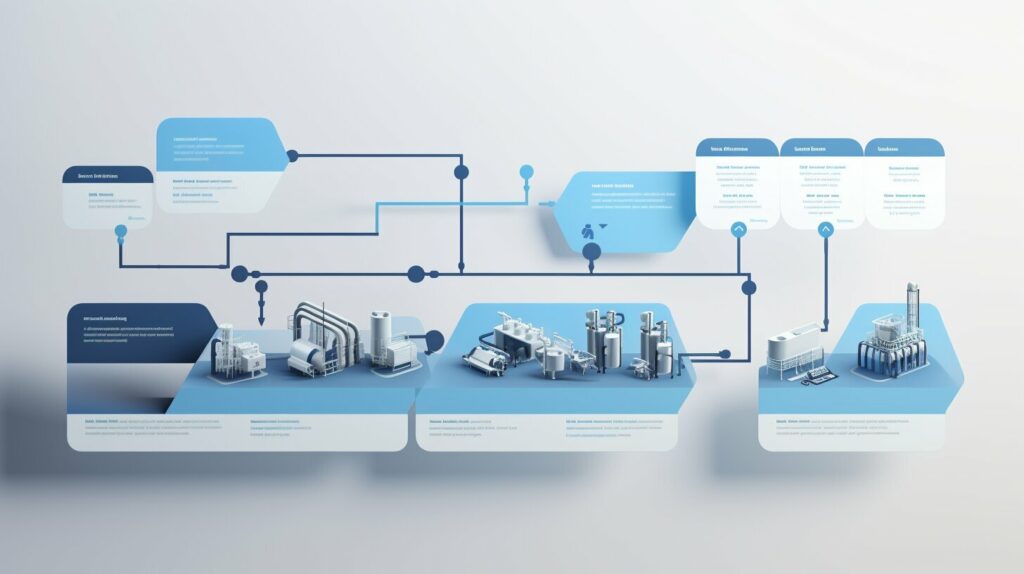Embarking on the journey of enhancing your business operations and efficiency? Look no further than the Business Process Guide Steps. Crafting a business process guide stands as a pivotal move in this direction. By offering a meticulous, step-by-step roadmap through your business operations, such a guide becomes a tool for recognizing areas ripe for improvement. In the upcoming section, we present a comprehensive guide outlining how to seamlessly construct a Business Process Guide in just five simple and effective steps.
Before we dive into the steps, it’s essential to understand the importance of business process management (BPM). A business process guide is a crucial element of BPM, and it helps to ensure that your business is running efficiently and effectively.
By documenting your business processes, you can identify areas for improvement and implement automation and optimization strategies.
Table of Contents
ToggleKey Takeaways
- Creating a business process guide can streamline your business operations and increase efficiency.
- A business process guide is an essential element of business process management (BPM).
- Documenting your business processes can help identify areas for improvement and implement automation and optimization strategies.
Understanding Business Process Management (BPM)
Before embarking on creating your business process guide, it is important to have a solid understanding of Business Process Management (BPM). BPM involves identifying, analyzing, and improving your business processes to make them more efficient and effective.
BPM is a continuous process of improvement and involves identifying areas that require improvement, analyzing the current state of your processes, designing and implementing changes, and monitoring the results. By improving your business processes through BPM, you can reduce errors, increase efficiency, and ultimately, improve your bottom line.
Process improvement starts with accurate business process documentation, which involves identifying and documenting all the necessary workflow steps. This documentation will help you map your business processes accurately and identify areas for improvement.

Business process mapping is a critical aspect of BPM that helps you visualize your processes and identify areas for improvement. There are various mapping techniques, including process flowcharts and value stream mapping.
Process automation is another key aspect of BPM that involves using technology to automate repetitive tasks, reducing the risk of errors and improving efficiency. To optimize your business processes for efficiency, you need to identify areas where automation can be applied, and implement the necessary changes.
Overall, understanding BPM is crucial to creating an effective business process guide. By incorporating BPM techniques, you can streamline your business operations and improve efficiency, ultimately leading to increased productivity and profitability.
Planning and Designing Your Business Process Guide
Creating a business process guide requires a strategic approach.
To get started, you must first identify the key steps involved in your business process. You can start by breaking down your workflow into smaller tasks and identifying the inputs and outputs of each step. This will help you map out a clear process flowchart that is easy to follow.
Once you have identified the key steps in your business process, you can start designing your business process guide. Your guide should provide a step-by-step approach to completing each task. Use clear and concise language to ensure that your guide is easy to follow.
Incorporating business process improvement techniques is also crucial. You can highlight areas where improvements can be made and provide examples of best practices to optimize your workflow. By doing so, your business process guide will become a valuable tool for improving your operations.
Steps to Create an Effective Business Process Guide
Follow these steps to plan and design an effective business process guide:
1. Identify the key steps in your business process.
Initiate the process by meticulously defining the core phases integral to your business process manual. Articulate the scope, objectives, stakeholders, and frequency of execution. Employ a structured process diagram template to delineate the primary phases and their corresponding sub-steps. Highlight the requisite inputs, outputs, and resource allocation for each phase.
2. Break down each step into smaller tasks.
Proceed by dissecting each phase into discrete and manageable tasks. Assign a descriptive label to each task, detailing its nature, responsible party, estimated duration, dependencies, and expected outcomes. Utilize a task analysis template to methodically capture these details, ensuring clarity and precision.
3. Map out a clear process flowchart.
Transition to crafting a comprehensive process flowchart to visually represent the sequential progression of your business process. The flowchart serves as an illustrative guide, presenting the sequence of steps, decisions, and interactions within the process. Leverage diverse shapes and symbols to denote distinct actions and connections. To create an aesthetically appealing and informative flowchart, consider utilizing a specialized flowchart generation tool.
4. Create a step-by-step guide for completing each task.
Forge a meticulous, step-by-step manual showing the execution of each task within your business process. Detail the precise actions, methodologies, and best practices required for task accomplishment. Enhance the manual’s comprehensibility by incorporating relevant visual aids, such as screenshots, images, and diagrams.
Utilize a standardized process documentation template to ensure consistent formatting and accessibility.
5. Incorporate business process improvement techniques and examples of best practices.
Elevate the caliber of your business process manual by integrating process enhancement methodologies and real-world examples of best practices. These methodologies encompass Lean, Six Sigma, Kaizen, and Value Stream Mapping, which streamline processes, minimize waste, and optimize outcomes.
Complement these techniques with successful practices that have garnered recognition in the industry. Benchmark your process against these standards to identify areas for refinement and innovation.

By using these steps, you can develop a comprehensive business process guide that will benefit your organization. Remember, your guide is a living document that should be updated regularly to reflect any changes in your workflow. Be sure to keep it up-to-date and accessible to all relevant employees.
SEE ALSO
- Business Process Guide Steps: How To Make One In 5 Steps
- Share Business Process Guide: How To Engage Stakeholders
- 3 Signs You Need a Business Process Review ASAP
Documenting and Mapping Your Business Processes
Effective documentation and mapping of your business processes are critical to ensuring optimal efficiency in your operations. Thorough documentation ensures that all steps are clearly outlined and understood, providing a basis for process improvement and optimization.
One of the most common mapping techniques is process flowcharting, which uses symbols to illustrate the various steps involved in each process. This allows you to identify areas where bottlenecks may occur, providing insight into where improvements can be made.
When documenting and mapping your business processes, it is important to use clear and concise language. Avoid using technical jargon that may not be understood by everyone involved in the process.
Once you have documented and mapped your current processes, you can begin to analyze them for inefficiencies and identify areas for improvement. This may include eliminating unnecessary steps, automating certain processes, or implementing new technologies.

Remember to regularly review and update your business process documentation to ensure that it remains relevant and accurate. By regularly analyzing and improving your processes, you can ensure that your business operations remain efficient and effective.
Implementing Process Automation and Optimization Strategies
Once you have created your business process guide, it’s time to implement process automation and optimization strategies to streamline your operations and improve efficiency.
First, use your guide to identify any manual tasks that can be automated. By automating these tasks, you can save time and reduce the risk of errors. Additionally, look for opportunities to optimize your processes by eliminating unnecessary steps or simplifying complex workflows.
To effectively implement process automation and optimization, consider using process mapping techniques to visualize your workflows and identify areas for improvement. Use your business process guide as a reference to ensure that each step is aligned with your overall business goals and objectives.

Remember, it’s important to continually analyze and improve your processes over time to ensure ongoing efficiency and success. By regularly reviewing and updating your business process guide, you can stay ahead of the competition and achieve optimal results.
Analyzing and Improving Your Business Processes
Once you have documented and mapped out your business processes and implemented automation and optimization strategies, it’s time to analyze and improve your processes. It’s important to regularly review and evaluate your business processes to identify areas of improvement and ensure that they remain efficient and effective.
Start by analyzing your business processes to identify areas of inefficiency or bottlenecks. Use process analysis techniques such as flowcharts and process maps to visualize the flow of your processes and identify areas that can be optimized.
Once you have identified areas for improvement, develop and implement process improvement strategies. This may involve introducing new technologies, streamlining workflows, or simplifying tasks to reduce the potential for errors and delays.
Continue to monitor and evaluate your business processes to ensure that your improvements are effective and sustainable. Regularly review your processes and make adjustments as needed to maintain optimal efficiency.
Remember that analyzing and improving your business processes is an ongoing process. By continuously evaluating and refining your processes, you can ensure that your business is operating at maximum efficiency and profitability.

Conclusion
Congratulations! You have now been introduced to the fundamental concepts and steps involved in creating a business process guide. By implementing these strategies in your business, you can expect to see an increase in efficiency and productivity, which can ultimately lead to increased profits.
Remember to keep in mind the importance of business process management, planning and designing your guide, documenting and mapping your business processes, implementing process automation and optimization strategies, and analyzing and improving your business processes. These key concepts will help ensure that your guide is comprehensive and effective.
Final thoughts
You should now have the necessary tools and knowledge to create a successful business process guide. Remember to consider factors such as process mapping, process documentation, process analysis and optimization in your guide. By incorporating these elements, you can develop an efficient workflow that will set your business apart from the competition.
Remember that no two businesses are the same, so tailor your guide to your specific needs and operations. With consistent analysis and improvement, you can ensure that your business process guide is effective and efficient for years to come.
Frequently Asked Questions – FAQs
How many steps are involved in creating a business process guide?
There are five simple steps involved in creating a business process guide.
What is business process management (BPM)?
Business process management is the practice of improving and optimizing business processes to achieve better efficiency and productivity.
How do I plan and design a business process guide?
To plan and design your business process guide, you need to identify the steps involved, adopt a step-by-step approach, and incorporate business process improvement techniques.
Why is documenting and mapping business processes important?
Documenting and mapping business processes helps in understanding and visualizing the workflow, allowing for better optimization and efficiency.
How can I implement process automation and optimization strategies?
By following your business process guide, you can implement process automation and optimization strategies to streamline operations and improve efficiency.
What is the importance of analyzing and improving business processes?
Analyzing and improving business processes is crucial for identifying areas of improvement, maximizing efficiency, and achieving optimal results.






